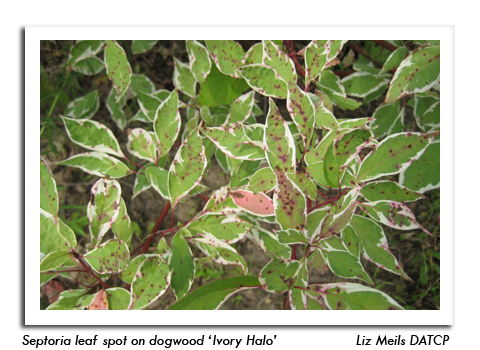
 |
|
|
Nursery & Forest
Volume 57 Number 6 Date 05/17/2012 VIRUS SURVEY OF ORNAMENTALS - A spring survey of ornamental perennials and annuals propagated in 17 greenhouses has found a range of hosts with plant viruses. Numerous anemone, astilbe, barrenwort, bleeding heart, hosta and phlox have been diagnosed with tobacco rattle virus (TRV). Cucumber mosaic virus (CMV) has also been found on many different host plants (see table below). Both viruses are readily transmitted through cuttings and pruning tools, whereas other viruses are vectored by nematodes, aphids and thrips. These viral plant diseases could infect most perennials and annuals as well as vegetables planted into gardens this season. Preventing the introduction of TRV and CMV into nurseries, greenhouses and home gardens is the best control measure. --Anette Phibbs, DATCP Plant Industry Laboratory SEPTORIA LEAF SPOT - Dogwood, phlox and spirea in Dane, Kenosha, Marquette, Racine, Walworth and Washington counties are showing symptoms of this common fungal disease, characterized by small reddish or purple lesions that first appear on the lower leaves and stems and later enlarge and spread to the upper leaves. Preventive measures such as increasing the spacing between plants and promoting air circulation can reduce its spread. Once symptoms appear, control is difficult to achieve. BRISTLY ROSE SLUG - The green, bristly larvae of this sawfly are feeding on the undersides of rose foliage in Kenosha and Marquette counties, and skeletonizing the leaves. Defoliation may be reduced by removing the larvae and infested leaves. Horticultural oils or residual insecticides are also effective. APHIDS - Assorted euonymus, plums, sedums and viburnums at retailers in Marquette, Racine, Walworth and Washington counties are moderately to heavily infested with aphids. These insects can directly damage nursery stock hosts when densities are high, but in most instances aphids are an aesthetic problem. Of larger concern is the secondary growth of sooty mold which results from their honeydew production. Insecticidal control is usually not required as there are many natural enemies that regulate populations. FOREST TENT CATERPILLAR - A prepupal, "wandering" larva was noted on May 14 in the DeForest area of Dane County. This species, unlike the similar eastern tent caterpillar, does not make a web. Reports of larvae were also received from Crawford, Grant and Sauk counties. --Liz Meils, DATCP Nursery Inspector GYPSY MOTH - Gypsy moth Btk treatments were applied from May 10-16 to sites in Barron, Chippewa, Clark, Eau Claire, Jackson, Polk and Trempealeau counties. An estimated 15,652 acres were treated. In addition, the gypsy moth-specific nucleopolyhedrosis virus (NPV) was applied twice to another 3,606 acres in Eau Claire and Jackson counties. Btk treatment is scheduled to continue through the end of this week, in Burnett, Dunn, Marinette and Rusk counties. Spraying has been completed for the year in Clark, Grant, Green, Iowa and Lafayette counties. --Nkauj Vang, DATCP Gypsy Moth Program 





|
|
|